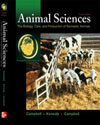
Aquaculture |  |
Chapter Summary| Aquaculture is one of the fastest-growing segments of animal agriculture. The importance and financial magnitude of aquaculture production in the United States has more than doubled during the last 15 years. Greater demand for fish products and reduced wild catches have fueled this increase in captive fish production. The raising of aquatic organisms under controlled systems includes species as diverse as trout, catfish, shrimp, and alligators. Chinese aquaculturists developed sustainable production systems 4000 years ago using fish that had different feeding niches. Today specialized producers harvest, process, and freeze thousands of pounds of boneless fish fillets for the consumer market.
Fish biology provides greater efficiency in producing meat than red meat animals through reduced energy expended for movement in a weightless environment, their being cold-blooded, and less energy expended for waste excretion. Maintenance of excellent water quality with sufficient dissolved oxygen and low concentrations of nitrogenous waste products are key aspects of profitable aquaculture production.
The food cycles in water systems of the world depend on microscopic animals that feed upon the phytoplankton and are in turn fed upon by larger organisms, ultimately yielding animal protein for direct human and domestic animal consumption. This cycle offers vast potential for improving the nutritional well-being of young and older humans alike in both developed and developing countries. With a higher priority for research related to fish and other aquatic life, the production of food in various bodies of water holds great promise in improving the nutrition of humanity on a global basis.
|
|
|